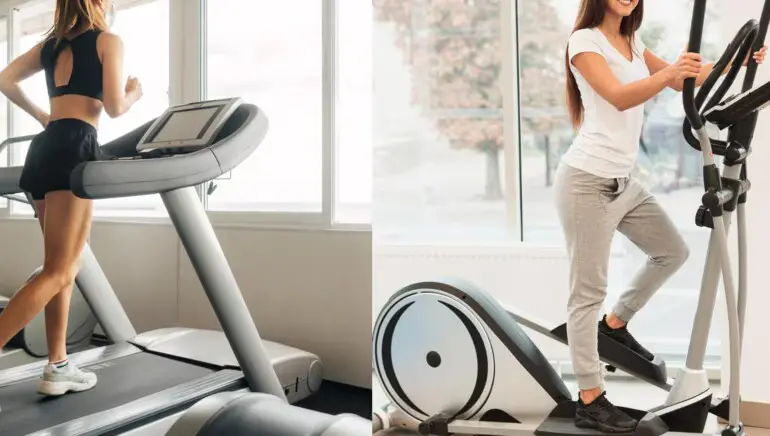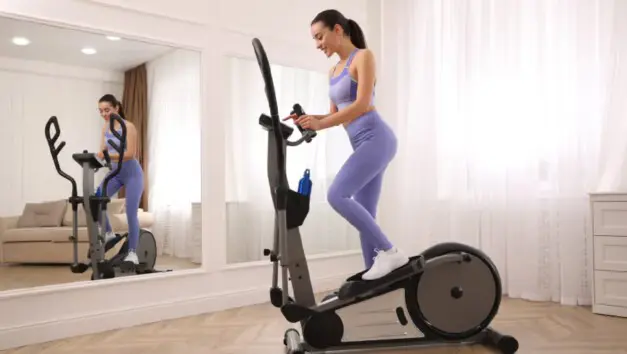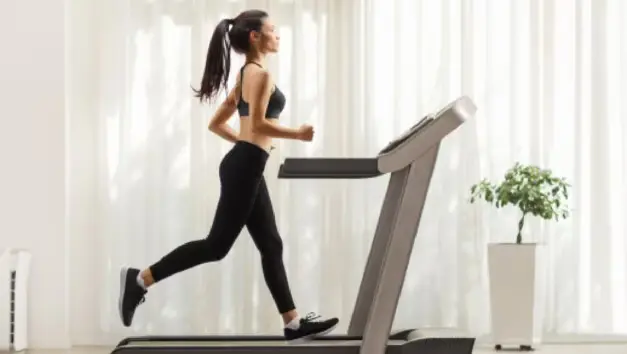Elliptical versus Treadmill: Which 1 is Best for Weight Loss?
Wondering if an elliptical or treadmill would help you lose weight? Here are the advantages and disadvantages of using an elliptical versus a treadmill to lose weight.
Most people want to lose weight to improve their health. Cardio activities are one of the most effective strategies to reduce weight. Jogging, jogging, brisk walking, and cycling are all fitness activities that can help you burn calories. However, if you want to work out indoors and use gym equipment, you will need to seek for alternative strategies to lose weight. Elliptical trainers and treadmills are prominent cardio devices in the fitness industry. Confused about whether to utilize an elliptical or a treadmill for weight loss? Read about their benefits and drawbacks to help you determine which is best for your weight-loss quest.
Also Read: Elliptical vs. Treadmill: Which Cardio Machine Is Better?
Elliptical versus Treadmill
What is an elliptical trainer?
An elliptical machine, often called an elliptical trainer or cross trainer, is a piece of stationary fitness equipment that simulates walking, jogging, and climbing stairs without placing too much pressure on the joints. It offers a low-impact cardiovascular workout by combining the movements of an exercise bike, stair climber, and treadmill. Users stand on the pedals and move their feet to train both upper and lower body muscles, providing an excellent full-body workout.
Elliptical trainers can help you gain overall fitness. Image courtesy of Adobe Stock.
Benefits of an Elliptical Trainer
Also Read;
Squats can assist to build and tone your legs. Image courtesy of Shutterstock
1. Promotes successful weight loss.
“The elliptical may burn 200 to 300 calories in 30 minutes, which is similar to jogging on a treadmill. Furthermore, the elliptical machine exercises the complete body. This is why include the elliptical machine in your training routine for weight loss might help you lose body fat,” explains fitness instructor Mahesh Ghanekar.
2. Easy on the joints.
The elliptical is a low-impact workout machine. If you have trouble dealing with the jarring action of walking or running, an elliptical machine might be a great answer. Low-impact exercise is frequently easier on your joints than high-impact exercise. This makes the elliptical a better option if you have osteoporosis, arthritis, or other musculoskeletal concerns including low back pain, knee discomfort, or hip trouble. A low-impact exercise may appear to be less demanding, yet it still provides a good aerobic workout. A 2017 research published in the Journal of Sports Medicine and Physical Fitness discovered that a 24-week low-impact training program improved participants’ body composition, physical fitness, and cardiovascular fitness.
[web_stories title=”false” excerpt=”false” author=”false” date=”false” archive_link=”true” archive_link_label=”” circle_size=”150″ sharp_corners=”false” image_alignment=”left” number_of_columns=”1″ number_of_stories=”5″ order=”DESC” orderby=”post_title” view=”circles” /]
3. Offers an upper and lower body exercise.
Some elliptical machines come with arm grips. You can move your legs while also pushing them back and forth. The resistance provided by the handles aids in working the muscles in your shoulders, chest, and back. The machine may also help you tone your lower-body muscles, including your quadriceps, hip flexors, and glutes.
Elliptical versus Treadmill
Side Effects of Elliptical Machines
1. Reduced muscular growth.
An elliptical is a terrific alternative for low-impact cardio exercise, while a treadmill may provide more muscle gain. If you want to develop your muscular strength while using an elliptical, try including weight or strength training into your workout program.
2. Not really lively.
On a treadmill, you may increase the incline to provide resistance to your workout. However, because the elliptical pedals are raised, your body does not carry your entire weight. Your movement encounters the least amount of opposition in return.
What is a treadmill?
Treadmills are motorized workout equipment with a moving belt that allow you to walk, run, or jog in place. They let customers to adjust the pace and slope settings and provide a controlled atmosphere for cardiovascular training. Treadmills are popular indoor running and walking equipment that provide convenience and flexibility to an exercise program.
Benefits of a treadmill:
1. Promotes weight loss.
“Running on a treadmill at 8 mph for 20 minutes may help you burn 200-300 calories. According to the expert, your body weight and degree of inclination also influence the quantity of calories spent. The optimal running method for a treadmill exercise is to run occasionally at an angle of at least 3 degrees (6 or 7 mph for one minute, followed by 13 or 14 mph for 10 seconds).
Running on a treadmill can help you lose weight. Image credit: Adobe Stock.
2. Engages the abdominal muscles.
Running requires you to engage your core and work your abdominal muscles. This increases balance, makes your body more robust, and prevents you from falling. So, if you run for 20 minutes, your core is active the entire time. Regular practice can help you create a strong core, improving your tone, posture, and endurance throughout the activity.
3. Suitable for lower-body workouts
Walking or jogging on the treadmill exercises your calves, hamstrings, quadriceps, glutes, abdominals, and heart muscles. It is thus a fantastic lower-body exercise. According to a research published in the Journal of Aging Research, intermittent treadmill exercise can help you burn fat in your lower body.
4. Strengthens bones.
Running demands you to maintain balance on alternating legs. This implies that your legs support your body weight alternately. Furthermore, the incline and pace of running generate forces that double or even triple your body weight. Running on multiple days with appropriate technique strengthens your bones.
5. Promotes heart health.
Running and walking quickly on the treadmill raises your heart rate and activates your lungs, which can help you strengthen your heart muscles and enhance circulation, according to a research published in the PubMed Journal. Over time, you will be able to run for longer periods of time without being out of breath, which will benefit your general health.
Elliptical versus Treadmill
Treadmill side effects:
1. Hard on joints.
Your knees may have difficulty running swiftly or gently on a treadmill for a lengthy period of time. That’s because your knees must support twice or three times your body weight. They also reduce the shock that occurs when your feet make contact with the platform.
2. Only works on the lower body.
Jogging or walking on a treadmill is a terrific lower-body workout, but it does not focus the upper body. Running on a treadmill may appear to be a full-body workout, but it does not train your upper body muscles much.
Using a treadmill can help you burn almost as many calories as using an elliptical. If you need a full-body exercise, use the elliptical. However, if you only need to work your lower body, a treadmill will suffice.
Elliptical versus treadmill: Which is better?
Both the elliptical machine and the treadmill have advantages and disadvantages when it comes to a good cardio exercise. However, what you pick for your fitness journey may be influenced by a variety of circumstances, including your current physical health. If you are prone to injuries or have a specific musculoskeletal issue, elliptical machines may be a better option because they are gentler on your bones and joints.
A treadmill, on the other hand, may be a better option if you are not prone to injuries or have joint problems, want to increase your fitness level, and want to enhance lower body strength.
Also Read: Cortisol Levels: Functions, Effects, and 9 Tips for Balance
Elliptical versus Treadmill
Health Conscious Plus
Welcome to Health Conscious Plus Find health insights, disease management tips, meal plans, and mindful living strategies for a healthier life.




